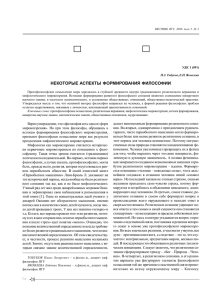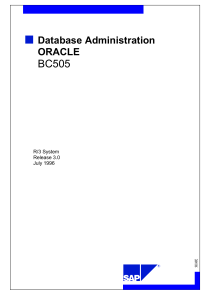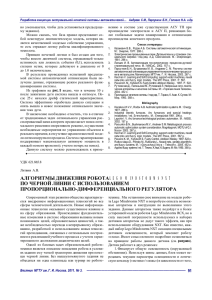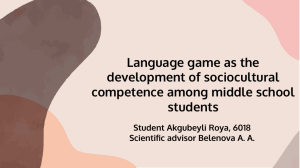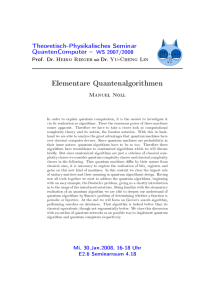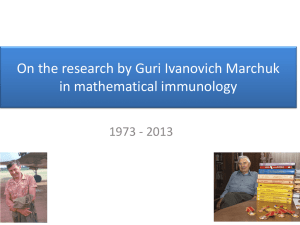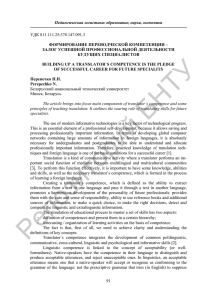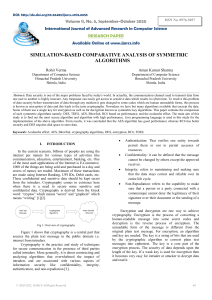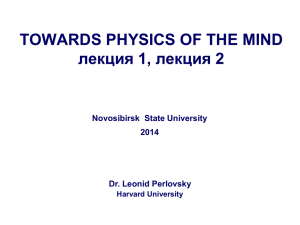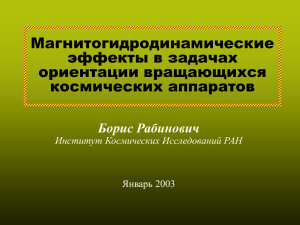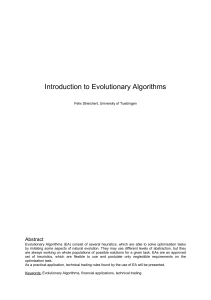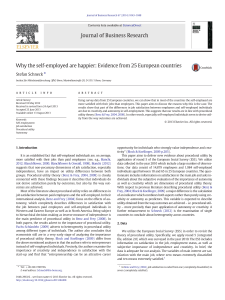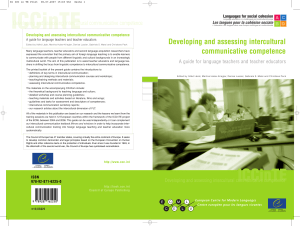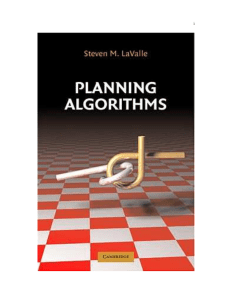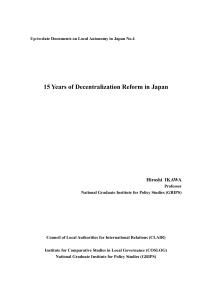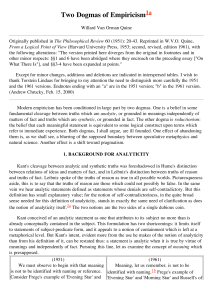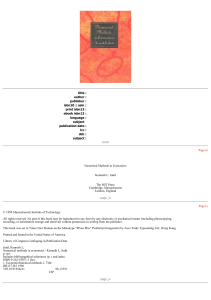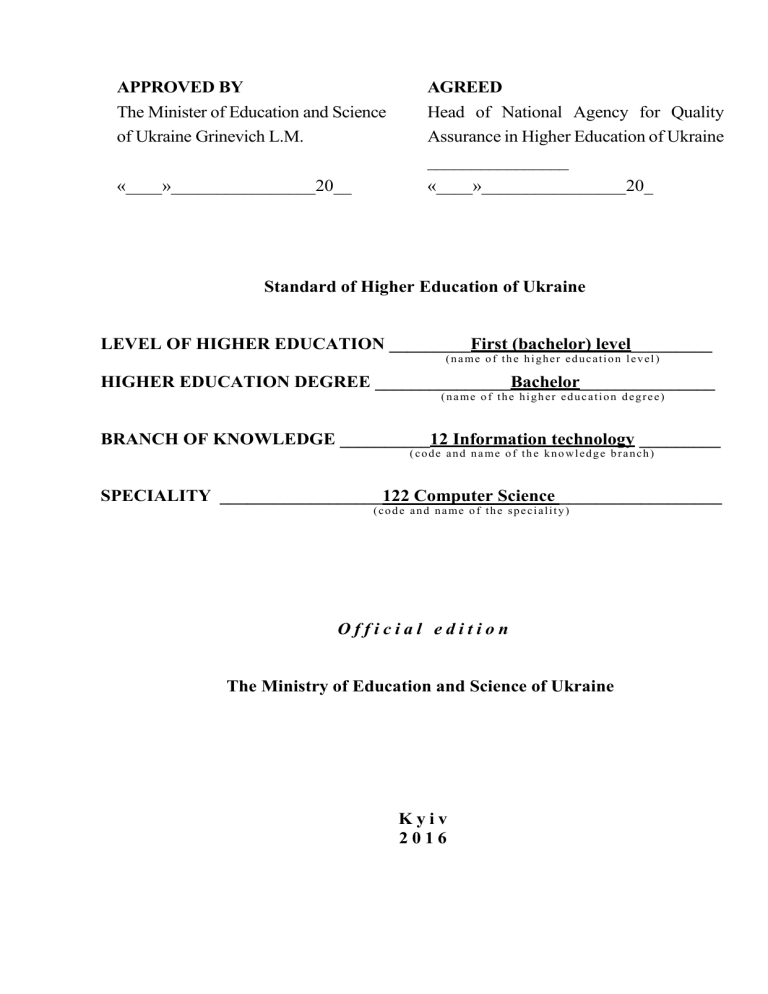
APPROVED BY The Minister of Education and Science of Ukraine Grinevich L.M. «____»________________20__ AGREED Head of National Agency for Quality Assurance in Higher Education of Ukraine ________________ «____»________________20_ Standard of Higher Education of Ukraine LEVEL OF HIGHER EDUCATION _________First (bachelor) level_________ ( n a m e o f t h e h i gh e r e d u c a t i o n l e v e l ) HIGHER EDUCATION DEGREE _______________Bachelor_______________ ( n a m e o f t h e h i gh e r e d u c a t i o n d e g r e e ) BRANCH OF KNOWLEDGE __________12 Information technology _________ ( c o d e a n d n a m e o f t h e kn o wl e d g e b r a n c h ) SPECIALITY __________________122 Computer Science __________________ (code and name of the speciality) Official edition The Ministry of Education and Science of Ukraine Kyiv 2016 І. Introduction Standards of higher education of Ukraine for the first (bachelor) degree of "Bachelor" for the branch of knowledge 12 "Information Technology" specialty 122 "Computer Science". APPROVED AND ENACTED by the Ministry of Education and Science of Ukraine ___________ ________ № _____ AUTHORS Kovaliuk Tetiana Volodymyrivna, Ph.D, Associate Professor of the department of Automated Systems of Information Processing and Management Department of the National Technical University of Ukraine "Igor Sikorsky Kyiv Polytechnic Institute", chairman of the subcommittee. Yerokhin Andriy Leonidovych, Doctor of Engineering, professor, Dean of the Faculty of Computer Science of Kharkiv National University of Radioelectronics. Mykhal'ov Oleksandr Illich, Doctor of Engineering, professor, доктор технічних наук, професор, head of the Department Information Technologies and Systems of the National Metallurgical Academy of Ukraine. Novozhylova Maryna Volodymyrivna, Doctor of Sciences, professor, head of the department of Economic Cybernetics and Information Technologies of the Kharkiv National University of Construction and Architecture. Subach Ihor Yuriyovych, Doctor of Engineering, docent, head of the department of combat use of mathematical and software of the automated control systems of the Military Institute of Telecommunications and Information Technologies Dmytriyeva Ol'ha Anatoliyivna, Doctor of Engineering, professor, head of the Department of Applied Mathematics and Computer Science of Donetsk National Technical University. Hlybovets' Mykola Mykolayovych, Doctor of Sciences, professor, dean of the Faculty of Informatics of the National University of Kyiv-Mohyla Academy. Krak Yuriy Vasyl'ovych, Doctor of Sciences, professor, h ead of the Department of theoretical cybernetics of Taras Shevchenko National University of Kyiv. Medykovs'kyy Mykola Oleksandrovych, Doctor of Engineering, professor, director of the Institute of Computer Science and Information Technology of Lviv Polytechnic National University. Cherevko Ihor Mykhaylovych, Doctor of Sciences, professor, dean of the Faculty of Mathematics and Informatics of Yuriy Fedkovych Chernivtsi National University. Yaroshko Serhiy Adamovych, Doctor of Sciences, head of the Department of Programming of Ivan Franko National University of Lviv. 2 REVIEWED AND APPROVED BY Scientific and methodical Sub-Commission 122-1 Computer Science and Information Systems (Computer Science) _________________ № _____ REVIEWED AND APPROVED BY Scientific and methodical Sub-Commission 8 of information technology, automation and telecommunications _________________ № _____ 3 Table of contents І. Introduction ................................................................................................................ 2 ІІ. General characteristics .............................................................................................. 5 ІІІ. Number of ECTS credits required for a bachelor’s degree..................................... 6 ІV. Graduate competencies ........................................................................................... 7 V. Normative content of university students 'preparation, formulated as learning objectives' terms ............................................................................................................ 8 VІ. The forms of higher education applicants certification ........................................ 10 VII. Requirements for the presence of internal quality of higher education system .. 10 VIII. Requirements of professional standards............................................................. 11 IX. The list of regulations underlying the higher education standart ......................... 11 Appendix A ................................................................................................................. 13 4 ІІ. General characteristics Higher education First (bachelor) level qualification Academic Degree Bachelor Branch of knowledge Speciality Limitations on forms of studies Qualification Diploma qualification Subject area description 12 «Information technology» 122 «Computer science» none «Bachelor of Computer Science» Qualification «Bachelor of Computer Science» Study focus points and/or activities: − mathematical, informational, simulations of real phenomena, objects, systems and processes; − models of data and knowledge presentation; − models, methods and technologies of receipt, storage, processing, transmission and use of information; − theory, analysis, development, estimation of efficiency, realization of algorithms; − methods and algorithms of operative multidimensional and intellectual analysis of data and decision making; − high-performance calculations, including parallel calculations and large data; − system analysis of objects and processes of computerization; − models of subject area and methods of construction of the intellectual systems based on knowledge and technologies of making decision; − methods and algorithms of recognition of sensory signals, sounds, images and characters; − mathematical providing of automated data processing systems and management, and information support of life cycle of industrial wares, programmatic systems and complexes, decision support system; − mathematical and programmatic providing of project works automation process, technology of visualization of data; − software, linguistic and informational providing of the different setting systems. Purpose of study: preparation of specialists able to conduct theoretical and experimental (including an imitation design) researches in industry of computer sciences; applying mathematical methods and algorithmic principles in a modelling, planning, development and accompaniment of information technologies and systems; carrying development, introduction and accompaniment of the intellectual systems of analysis and processing of data in the organizational, technical, natural and socio-economic systems. Theoretical contents of the subject area: modern models, methods, algorithms, technologies, processes and methods of receipt, presentation, processing, analysis, transmission, storage of data in the information 5 systems with the purpose of their systematization and exposure of necessary facts for information. Methods, techniques and technologies: mathematical models, methods and algorithms for solving theoretical and applied tasks emerging in the development of IT and IS; date technologies and programming platforms; methods of data collection, analysis and consolidation of distributed information; technology and methods of design, development and quality assurance of IT and IS components; computer graphics and visualization technology methods; engineering knowledge technologies. Tools and equipment: IT and IS CASE-technology modeling and design; distributed computing system; computer networks; cloud computing, database management systems, operating systems. Alumni Academic Ability of continuing education for the second (master's) level of higher education. Rights ІІІ. Number of ECTS credits required for a bachelor’s degree The volume of the educational program of bachelor of Computer Science: − on the basis of complete general secondary education with 11 years study period 240 ECTS Credits; − on the basis of complete general secondary education with 12 years study period 180-240 ECTS Credits. At least 50% of the programme's curriculum has to be aimed at providing general and specific (professional) competencies determined by higher education standards. In order to reach a Bachelor degree on the basis of a Junior Bachelor degree a higher education institution has the right to shorten the scope of a programme 6 ІV. Graduate competencies Integrated competence Bachelor (FQ-EHEA - first cycle, EQF LLL - 6 level, HPK - 6 level) is able to solve complex problems and specialized tasks in computer science, which involves the application of theories and techniques of computer science, information technology and characterized by complexity and uncertainty conditions. General competences GC1. Ability for abstract thinking, analysis and synthesis. GC2. Ability to apply knowledge in practical situations. GC3. Knowledge and understanding of the subject area and understanding of the profession. GC4. Ability to communicate both orally and through the written word in the first language. GC5. Ability to communicate in a second language. GC6. Capacity to learn and stay up-to-date with learning. GC7. Ability to search for, process and analyse information from a variety of sources. GC8. Ability to generate new ideas (creativity). GC9. Ability to work in a team. GC10. Ability to be critical and self-critical GC11. Ability to design and manage projects. GC12. Ability to make reasoned decisions. GC13. Ability to evaluate and maintain the quality of work produced. GC14. Determination and perseverance in the tasks given and responsibilities taken. GC15. Ability to act on the basis of ethical reasoning. SC1. Ability to think mathematical and logical, formulate and research of mathematical models, in particular discrete mathematical models, give reasons why choosing methods and approaches for uniting of theoretical and applied tasks in industry of computer sciences, analysis and interpretation. SC2.Ability to find out conformities to law of the casual phenomena, apply the methods of the statistical processing of data and evaluation of stochastic processes. SC3.Ability to draw logically-grounded conclusions, use formal languages and models of algorithmic calculations, plan, develop and analyse algorithms, estimate their efficiency and complexity, and solvability and insolvability of algorithmic problems for modeling subject areas and creating software and information systems. Specific competences SC4.Ability to gain proficiency in modelling of mathematical objects processes and phenomena, to develop models and algorithms of mathematical objects modelling taking errors of approach solutions into account. SC5.Ability to comply formalized description of operation research problems in technical-organizational and socio-economic systems of different purposes, determine their optional solutions, build models of optimal choice of management taking into account the changes of economic situation parameters, optimize management processes in the systems of different setting and level of hierarchy. 7 SC6.Ability for system thinking, applying system analysis methodology for different researching problems of different purposes and formalization methods, as well as solving system problems with discrepant goals, uncertainties and risks. SC7.Ability to use theoretical and practical bases of methodology and modeling technology, implement of modeling algorithms to research the characteristics and behavior of complex objects and systems, carry out experiments using modeling software with results processing and analysis. SC8.Ability to project and develop software using different programming paradigms: generic, object-oriented, functional, logic with appropriate models, methods and calculation algorithms, data structures and control mechanisms. SC9.Ability to implement tiered computing model based on client-server model, including databases and data storage to suit many users, perform transaction processing, including cloud services. SC10.Ability to use methodologies, technology and tools for managing life cycle processes of information and program systems, products and information technology services according to customer requirements. SC11.Ability for intellectual multivariate data analysis and efficient analytical processing with results of analysis visualization in a process of solving applied problems of computer science. SC12.Ability to ensure organization of calculating processes in informational systems of different purposes taking architecture, configuration, indicators of operating system and system software functioning productivity into account. SC13.Ability to develop networking software functioning on the basis of structured cable systems different topologies, uses computer systems and data networks and analyses the quality of computer networks. SC14.Ability to use the methods of information security, develop and operate specialized information resources objects of critical information infrastructure software. SC15.Ability for analysis and business processes functional modeling, construction and practical application of functional models of organizational and economic, industrial and technical systems, risk assessment methods for designing integrated circuits, synthesis of complex systems based on the use of computer models. SC16.Ability to implement high-performance computing based on cloud services and technologies, parallel and distributed calculations in the development and operation of distributed parallel processing. V. Normative content of university students 'preparation, formulated as learning objectives' terms PR1. To apply fundamental knowledge of basic forms and laws of abstract logical thinking, basics of scientific knowledge methodology, forms and methods of 8 exclusion, analysis, processing and synthesis of information in computer science subject area. PR2. PR3. PR4. PR5. PR6. PR7. PR8. PR9. PR10. PR11. PR12. PR13. To use mathematical apparatus of continuous and discrete analysis, linear algebra, analytic geometry in professional practice for solving theoretical and applied problems in the projection process and implementation of information objects by sector. To demonstrate knowledge on regularities of random phenomena, their properties and operations on them, stochastic process models and modern development environment for solving problems of experimental data statistical processing and predictive modeling. To plan, develop and analyze algorithms of solving computational and logical problems, evaluate the effectiveness and complexity of algorithms taking the use of formal models of algorithms and computable functions into account. To apply basic knowledge of numerical differentiation and integration of functions methods, solution of ordinary differential and integral equations, features of numerical methods and capabilities to adapt them to engineering problems, to have the skills of programming of numerical methods. To demonstrate fundamental understanding of organizational and technical systems simulation and operations simulation; methods of operations research, solution one - and multi-criteria optimization tasks of linear, integer, nonlinear, stochastic programming. Ability to use the methodology of the simulation modelling of objects, processes and systems, to plan and to run experiments with models, the decision making to achive the goal by the simulation results. Ability to develop software models of subject environments, to select a programming paradigm from the position of convenience and quality of usage to implement methods and algorithms for solving tasks in computer science field. To use tools for developing client-server applications, to design conceptual, logical and physical models of databases, to develop and optimize queries thereto. To create distributed databases, storages and data marts, knowledge bases, including cloud services, using web programming languages. To have skills of using the management techniques of software lifecycle, information technology products and services in accordance with the requirements and restrictions of the customer, to be able to prepare project documentation (feasibility study, technical requirement, business plan, creative brief, contract, agreement etc.). To be able to apply the methods and algorithms of data mining for classification tasks, forecasting, cluster analysis, searching of associative rules by using software tools of support multidimensional data analysis through the use of technology DataMining, TextMining, WebMining. To know the system programming languages and software programs development methods that interact with components of computer systems, to demonstrate knowledge of network technologies, architecture of computer networks and practical skills in technology management of computer networks and their software. 9 PR14. To apply knowledge of methodologies and CASE-means of designing the complex systems, methods of structural analysis of systems, object-oriented design methodology in the process of construction and practical application of functional models of organizational and economic, production and technical systems. PR15. To demonstrate knowledge of information security concepts, principles of safety software design, to ensure the safety of computer networks in conditions of uncertainty and incomplete source data. PR16. To perform parallel and distributed computing, to apply numerical methods and algorithms for parallel structures, parallel programming languages when developing and operating of parallel and distributed software. VІ. The forms of higher education applicants certification The forms of higher education applicants certification Requirements for qualifying work The final state attestation is performed in the form of defence the graduate qualification work of the bachelor (diploma project or work). Qualification work should include theoretical, system integrator or experimental study of one of the crucial tasks of specialty 122 “Computer Science” and demonstrate the ability of the author to use the achievements of competence and learning outcomes, logically, based on modern scientific methods, to express their views on research, make well-founded conclusions and formulate concrete proposals and recommendations on the solved problem and identify the author's tendency to research or practice. The objects of research can be different nature phenomena, production processes, technologies, activities in the framework of formulated problem. Qualification work must be checked for plagiarism. Higher educational institution (HEI) should define the requirements for the content, scope and structure of qualification bachelor work. Topics and annotations of the graduate qualification works of the bachelors should be published on the official website of the HEI or its division (faculty, institute, department). VII. Requirements for the presence of internal quality of higher education system HEI should provide the quality assurance system of the educational activities and quality of higher education (system of internal quality assurance), which includes the following procedures and measures: 1) determination of principles and procedures for quality assurance of higher education; 2) monitoring and periodic review of education programs; 10 3) annual evaluation of students, research and teaching staff of higher educational institution and regular publication of the results of such assessments on the official website of the HEI, on notice boards and in any other way; 4) providing the skills upgrading of educational and scientific employees in the form of training or pass courses with obtaining relevant supporting documents at least once every five years or by defense of a thesis; 5) providing the necessary resources for the educational process, including independent work of students at each educational program; 6) providing the availability of information systems for the efficient management of the educational process; 7) attracting educational sector employers to participate in the preparation and implementation of educational programs of specialty 122 “Computer science and information technologies” and its specializations, coordination with them educational and professional standards; 7) providing the publicity of information about educational programs, higher education degrees and qualification; 8) development practices of academic honesty, specifically providing an effective system of prevention and detection of plagiarism in scientific works of HEI employees and students; 9) other procedures and measures. The system of providing by higher educational institution the quality of higher education (system of internal quality assurance) upon the submission of HEI, evaluated by National higher education quality assurance agency or by accredited independent institutions of higher education evaluation and quality assurance for its compliance with the requirements for quality assurance in higher education, approved by the National higher education quality assurance agency, and international standards and guidelines for quality assurance. VIII. Requirements of professional standards The corresponding professional (multi) national organisational standard for the programme 122 "Computer Science and Information Technology" is absent as of the standard development date. IX. The list of regulations underlying the higher education standard 1. Закон України від 01.07.2014 № 1556-VII «Про вищу освіту»; 2. Постанова Кабінету Міністрів України від 23.11.2011 р. № 1341 «Про затвердження національної рамки кваліфікацій»; 3. Постанова Кабінету Міністрів України від 29.04.15 року № 266 «Про затвердження переліку галузей знань і спеціальностей, за якими здійснюється підготовка здобувачів вищої освіти»; 4. Класифікація видів економічної діяльності : ДК 009:2010. – На заміну ДК 009:2005; Чинний від 2012-01-01. – (Національний класифікатор України); 11 5. Класифікатор професій : ДК 003:2010. – На заміну ДК 003:2005 ; Чинний від 201011-01. – (Національний класифікатор України); 6. Области образования и профессиональной подготовки 2013 (МСКО-О 2013): Сопроводительное руководство к Международной стандартной классификации образования 2011. – Институт статистики ЮНЕСКО, 2014. – Режим доступу: http://www.uis.unesco.org/Library/Documents/isced-f-2013-fields-of-educationtraining- 2014-rus.pdf; 7. Стандарти і рекомендації щодо забезпечення якості в Європейському просторі вищої освіти. К. : Ленвіт, 2006. – 35 с. ISBN 966-7043-96-7; 8. Національний освітній глосарій: вища освіта / 2-е вид., перероб. і доп. / авт.- уклад. : В. М. Захарченко та ін. / За ред. В. Г. Кременя. – К. : ТОВ «Видавничий дім «Плеяди», 2014. – 100 с. ISBN 978-966-2432-22-0. 9. Наказ МОН України від 01.06.2016 № 600 «Про затвердження та введення в дію Методичних рекомендацій щодо розроблення стандартів вищої освіти». 10. Computer Science 2013: Curriculum Guidelines for Undergraduate Programs in Computer Science. [Електронний ресурс]. Режим доступу: http://www.acm.org/education/CS2013-final-report.pdf 11. Бахрушин В.Є. Компетентності і результати навчання у нових стандартах вищої освіти [Електронний ресурс]. Режим доступу: http://education-ua.org/ua/articles/702kompetentnosti-i-rezultati-navchannya-u-novikh-standartakh-vishchoji-osviti 12. Класифікація видів економічної діяльності : ДК 009:2010. – На заміну ДК 009:2005; Чинний від 2012-01-01. – (Національний класифікатор України); 13. Класифікатор професій : ДК 003:2010. – На заміну ДК 003:2005 ; Чинний від 201011-01. – (Національний класифікатор України); 12 Appendix A Table 1 – Compliance matrix based on standard of NQF descriptors competence Competence classification by NQF Knowledge Skills Communication Autonomy and responsibility Implementation of social communication in the process of communicating with specialists and nonspecialists in computer science, ensuring the exchange of logical arguments to achieve mutual understanding and agreement The ability to sociability, emotional stability, endurance, stroke, defending own point of view, clear expression of their opinions The responsibility for assigned work, autonomy in decision-making on solving problems in computer science Generic competences 1. Ability for abstract thinking, analysis and synthesis. A knowledge of the basic forms and laws of the abstract-logical thinking, basics of the logic, critical approach standards, basics of the methodology of the science knowledge, forms and methods of the analysis and synthesis 2. Ability to apply knowledge in A knowledge of teaching practical situations. methods, organization and implementation, promotion and motivation 3. Knowledge and understanding of the subject area of teaching and learning of understanding and understanding of the computer science subject profession. area Gaining systematic knowledge in computer science, analyzing the problem in terms of current scientific paradigms, interpreting and making reasonable conclusions from scientific and educational literature and experimental results Implementation of learned concepts, theories and methods of the intellectual and practical activities in computer science, reflection of the content and sequence of ways for performing actions summarizing and organizing the results of work Ability to organize the work to achieve results, performance and mental and practical actions, methods and operations of awareness of responsibility for their activities, the use of selfmonitoring and selfevaluation 13 Competence classification by NQF Knowledge Skills Communication Autonomy and responsibility 4. Ability to communicate both orally and through the written word in the first language. A knowledge of lexical, grammatical and stylistic features of state and foreign vocabulary, computer science terminology, grammar to understand and produce oral and written foreign texts in professional field Professionally meeting state and foreign languages, developing the state and foreign languages for documentation systems, products and services information technology to read, understand and use technical documentation in Ukrainian and foreign languages in professional activity. Possession and usage of typical professional communication lexical and syntactic models, building communication in speech and writing state and foreign languages, based on the objectives and the situation of communication. The responsibility for an accuracy and correctness of the statements in official and foreign languages A knowledge of techniques and teaching methods, self-education methods, basic scientific and research activities, methods of searching, collection, analysis and processing of information Assessing the subject of educational activity, defining a common goal and specific tasks, choosing the adequate means to solve tasks to achieve the result, making the necessary selfcontrol, using reference books and technical documentation, developing and applying creativity in professional activity, organizing workplace, planning working time. A usage of communicative competence for an effective cooperation in different areas of communication; selection and systematization of information materials with a goal to communicate in a professional field, use media to receive, process and create actual information in form of documents, abstracts, reports, articles, interviews; improvement of personal communicational competency based on skills Take a responsibility for professional development, exercise independence in carrying out independent generalizations, make independent decisions and perform independent actions in overcoming learning difficulties, based on experience in creative solution of problems. 5. Ability to communicate in a second language. 6. Capacity to learn and stay upto-date with learning. 14 Competence classification by NQF Knowledge Skills Communication and abilities of interpersonal communication. Using the system of document-information communications to meet the information needed in the field of Computer Science and Information Technology. Autonomy and responsibility 7. Ability to search for, process and analyse information from a variety of sources. A knowledge of methods, techniques and technology of collecting information from various sources, analysis content of documents, analysis and data processing Using technology and tools of search engines, methods of data mining and text, processing interpretation and synthesis of data. 8. Ability to generate new ideas (creativity). A knowledge of basic steps and stages of the creative process, role of correctly formulated purposes and problems for their achievements in the field of computer science, human creativity ability, the mechanism of the genesis and development of knowledge, methods of generating ideas, understanding of creativity as a universal process of unusual ideas generating. A knowledge of the teamwork principles, team values, conflict foundations. Knowledge management of IT project Showing curiosity, appetite for risk, ability to think, get inspired by new ideas, implement them, light them around, combine and experiment. Making professional contacts and communication, understanding interlocutors psychological effect in the communication process, adequate understanding of verbal and nonverbal communication signals, ability to overcome communication barriers. Autonomy and responsibility for generating new ideas and decision making in the field of computer science in the development of methods, models, algorithms and their implementation. Building connections and relationships with people, taking into account the opinion of colleagues, to understand other people, The ability to plan communication in a team with customers, respect correct behavior, tolerance, rights, acknowledgment The ability to express thoughts while working in a team, being responsible for the work team, the ability to take 9. Ability to work in a team. 10. Ability to be critical and selfcritical. Autonomy in the processing, interpretation and synthesis of data, responsibility for the timeliness, accuracy and reliability of presentation. 15 Competence classification by NQF Knowledge 11. Ability to design and manage projects. methodology, RMBOK standards, software tools for IT projects managing. 12. Ability to make reasoned decisions. 13. Ability to evaluate and maintain the quality of work produced. Skills expressing confidence the team to recognize their mistakes, avoiding and preventing conflicts, containing personal ambitions. Carrying out the selection and preparation of information and tasks for the project team, setting goals, formulating objectives and goals for projects and programs implementation. A professional knowledge Conducting analysis of the in Computer Science, strengths and weaknesses knowledge of of the decision, analyzing methodological the opportunities and risks approaches to training of decisions, evaluating the procedures for decision effectiveness of decisions. making of organizational and managerial nature, manner behavior in unusual situations. A knowledge of Applying in the international standards for international standards of quality assessment quality assessment software, services and IT software, services and IT management services, management services, model for evaluating the valuation models of maturity of software software development development processes, processes maturity. Communication Autonomy and responsibility thoughts of another person and the ability to take part in the proper debate, overcome selfish attitudes, principles of self-criticism, distribution of information about the progress of work. responsibility to the team as a leader. Conducting business negotiations for the transfer of information using analysis, reasoning and counter-argumentation. The ability to take responsibility for decisions, including decisions in unusual situations, the ability to defend decision. The development of communications plans in the project; preparing and conducting meetings; problem diagnosis and conflicts during the work. The ability to take responsibility for the quality of work, enforcement of contractual rights and obligations. 16 Competence classification by NQF 14. Determination and perseverance in the tasks given and responsibilities taken. 15. Ability to act on the basis of ethical reasoning. Knowledge methods, quality assurance of IT systems. The ability to adjust focused behavior by circumstances that prevent the achievement of goals, overcoming various obstacles. A knowledge of the system of general rules of moral behavior and human groups of people, ethics, understanding the code of professional ethics. Skills Communication Autonomy and responsibility Analyzing problematic situations, asking themselves specific goals for solving professional problems and consciously seeking their implementation, choosing the path for future action, determining the means to achieve goals, making decisions. The ability to develop communication in the team, find understanding in the implementation of individual tasks and fulfillment of obligations. The ability to prepare to meet problems, develop design solutions taking uncertainty into account, develop appropriate guidance and regulations as well as proposals and measures to implemented projects and programs. Implementing a system of moral relations in professional activities. The ability to plan and implement interpersonal communication based on certain moral principles. The ability to take responsibility towards colleagues and the public the result of work, the ability to support the reputation of the group, compliance with moral prohibitions and requirements. The ability to form effective communication strategy through accuracy reasoning in mathematical outlining. The ability to solve professional tasks using modern mathematical tools and take responsibility for the derived solutions. Specific competences 1 Ability to think mathematical and logical, formulate and research of mathematical models, in particular discrete mathematical models, give reasons why choosing methods and approaches for untiing of theoretical and applied tasks in A knowledge of theoretical and applied provisions of continuous and discrete analysis, including analysis of the infinitely small, integral calculus, linear algebra, analytic geometry, Effectively using modern mathematical tools in professional activities for solving theoretical and applied in the analysis, synthesis and projecting of information systems. 17 Competence classification by NQF Knowledge Skills Communication Autonomy and responsibility differential equations, functional analysis, combinatorics, graph theory, Boolean algebra. 2. Ability to find out A knowledge of patterns conformities to law of the casual of random phenomena, phenomena, apply the methods of their properties and the statistical processing of data operations on them, and evaluation of stochastic random variables and processes. distribution laws, probability methods of complex systems, basic concepts of mathematical statistics, empirical data processing methods, verification of statistical hypotheses based on sample data, elements of the theory of regression and correlation. Solving typical tasks using basic theorems of probability theory; building distribution laws of random variables and calculating their numerical characteristics; building models of random processes and carrying out their analysis; applying probabilistic and statistical methods for evaluation of stochastic processes; using modern environment for solving statistical analysis of experimental data. The ability to substantiate an own opinion about application of statistical data and evaluation of stochastic processes in the real world in communication with colleagues, customers, partners, create analytic and written reports and to use the own work results at meetings, conferences, etc. The ability to solve professional tasks using modern mathematical apparatus of probability and mathematical statistics, take responsibility for the derived solutions. 3. Ability to draw logicallygrounded conclusions, use formal languages and models of algorithmic calculations, plan, develop and analyse algorithms, estimate their efficiency and complexity, and solvability and insolvability of algorithmic problems for modeling subject areas and creating software and information systems. Using formal models and algorithms, computable functions, setting solvability, partial solvability and unsolvable algorithmic problems to project, develop and analyze algorithms, evaluating their performance and complexity. The ability to communicate with colleagues, customers, partners on specific issues of projecting and modeling of information systems and software, write analytical reports, present the results of their work at meetings, conferences etc. The ability to substantiate own opinion on the design, development and analysis of algorithms and computable functions in the subject area modeling. industry of computer sciences, analysis and interpretation. A knowledge of the basic concepts of the theory of algorithms, formal models of algorithms, primitive recursive, general recursive and partially-recursive functions, solvability and insolvability of massive problems, the concepts of time and space 18 Competence classification by NQF Knowledge complexity of algorithms for solving computational problems. 4. Ability to gain proficiency in A knowledge of modelling of mathematical numerical methods of objects, processes and linear and non-linear phenomena, to develop models algebra, functions and algorithms of mathematical approximation, numerical objects modelling taking errors of differentiation and approach solutions into account. integration of functions methods, solving ordinary differential, integral equations and partial differential equations, numerical methods theoretical features and capabilities to adapt them to engineering problems. Skills Using mathematical packages and developing programs of numerical methods implementation, reasonable choosing of numerical methods for solving engineering problems in the projecting and modeling of software and information systems and technologies, evaluating the effectiveness of numerical methods, including convergence, stability and complexity of implementation. 5. Ability to comply formalized A knowledge of concepts Formulating organizational description of operation research of operation, operating goal for technical and problems in technicalsystem, model operation, economic systems organizational and sociomodel development management, forming a economic systems of different operations stages; system of quality control purposes, determine their classification of economic criteria, building a optional solutions, build models and mathematical models mathematical model of the of optimal choice of management and methods; principles problem, selecting and taking into account the changes of organizational and using the appropriate of economic situation parameters, technical systems and method for solving the optimize management processes operations modeling; optimization problem and in the systems of different setting methods of solution of finding its optimal solution, and level of hierarchy. linear, integer, nonlinear, adjusting the solution of the Communication Autonomy and responsibility The ability to substantiate an own opinion about the problem that is solved, communicate with colleagues, customers, partners on specific issues of projecting and simulation software and information systems and technologies, create analytic and written reports and to use the own work results at meetings, conferences, etc. The ability to independently determine the formulation of the problem, choose a numerical method for solving it, ensure the required accuracy of performed calculations, take responsibility for derived solutions. The ability to substantiate an own opinion about the problem that is solved, communicate with colleagues, customers, partners on specific issues of the enterprise, institution, organization, create analytic and written reports and to use the own work results at meetings, conferences, etc. The ability to solve problems on professional activities using modern methods, technical and scientific literature, modern software; perform certain functions of organizational and technical management related to information processing, modeling analysis of situations, training solutions to 19 Competence classification by NQF Knowledge Skills stochastic and dynamic programming; features of multiple tasks construction and solving. model based on new knowledge about the problem and the operation, making management decisions about operations and the implementation of this decision, using software for searching of optimal solutions of organizational and economic governance. Describing the subject area, for applying the principles of system approach for information systems and informatization objects modeling and projecting, to carrying out a systematic analysis of business process management systems, uncertainty disclosing and analyzing multifactorial risks; finding solutions for weakly structured problems. 6. Ability for system thinking, applying system analysis methodology for different researching problems of different purposes and formalization methods, as well as solving system problems with discrepant goals, uncertainties and risks. A knowledge of system analysis methodology for a systematic study of deterministic and stochastic models of objects and processes, projecting and operation of information systems, products, services, information technology and other objects of professional activity. 7. Ability to use theoretical and practical bases of methodology and modeling technology, implement modeling algorithms to research the characteristics and A knowledge of queuing models, Petri nets; probabilistic methodology and simulation facilities, Identifying the components of structural and parametric identification of models of real systems, applying the modeling of complex Communication Autonomy and responsibility optimize the activities of information systems organization. The ability to substantiate an own opinion about the system analysis of complex objects and processes, formalization methods of system tasks when designing complex systems, communicate with colleagues, clients, partners about the specific problems of information and program systems design, create analytic and written reports and to use the own work results at meetings, conferences, etc. The ability to substantiate own opinion on models and methodologies of projecting of objects and processes, communicate with The ability to selfevaluate and form a unit of study, determine the feasibility and possibility of solving the existing uncertainty to formalize the task, take responsibility for decisions regarding the logical organization, properties and behavior of projected complex systems. The ability to independently determine the staging task to build an information model, choose the method or 20 Competence classification by NQF Knowledge Skills Communication Autonomy and responsibility behavior of complex objects and systems, carry out experiments using modeling software with results processing and analysis. processes and systems; planning and conducting experiments with models of decision making to achieve the goal by the simulation results. objects and systems using appropriate software, assessing the completeness, adequacy, validity and feasibility models of real systems. colleagues, customers and partners on specific issues of methodology and modeling technology facilities and systems, write analytical reports, make performances with the results of work at meetings, conferences, etc. The ability to form effective communication strategy in the software development team, make decisions about programming paradigms, methods and algorithms for computing, data structures and mechanisms of control. environment modeling, perform modelling of an object or a system, take responsibility for the decision to achieve the goal according to the simulation results. The ability to substantiate an own opinion about architecture and technology of client-server applications development, including database and data storage, form a communication strategy with colleagues, customers, partners on specific issues of the The ability to work in a team to implement tiered client-server applications, integrate databases and data storage in the development of distributed software to be responsible for decisions regarding the logical 8. Ability to project and develop software using different programming paradigms: generic, object-oriented, functional, logic with appropriate models, methods and calculation algorithms, data structures and control mechanisms. A knowledge of basic data structures and algorithms, methodologies and tools for object-oriented analysis and design, characteristics of different programming paradigms, principles, models, methods and technologies for the design and development of software products for various purposes. 9. Ability to implement tiered A knowledge of computing model based on client- principles, tools, web server model, including databases programming languages, and data storage to suit many technologies of creation users, perform transaction of databases, repositories, processing, including cloud data marts and knowledge services. base for the development of distributed applications with integration of databases and data Software models of subject media developing, choosing a programming paradigm from the standpoint of convenience and quality for implementing the use of methods and algorithms for solving problems in computer science for reliable and efficient software creation. Using methods, technologies and tools for projecting and development of clientserver applications, projecting conceptual, logical and physical models of databases, developing and optimizing queries which create distributed The ability to prepare problems and develop project solutions, taking into account uncertainties, develop appropriate guidance and regulations as well as proposals about implementing developed projects and programs. 21 Competence classification by NQF Knowledge warehouses in a clientserver architecture. 10. Ability to use methodologies, technology and tools for managing life cycle processes of information and program systems, products and information technology services according to customer requirements. 11. Ability for intellectual multivariate data analysis and efficient analytical processing with results of analysis visualization in a process of solving applied problems of computer science. 12. Ability to ensure organization of calculating processes in informational systems of Skills database repository and data marts, knowledge base, including cloud services. Communication development of client-server applications, create analytic and written reports and use the own work results at meetings, conferences, etc. A knowledge of Using methodologies, The ability to develop and standards, methods, technologies and tools for communicate with Ukrainian technology and process lifecycle management of and foreign partners, current management lifecycle information systems, interaction and joint information and software software, products and elaboration of decisions and systems, products and services of information initiatives on development services of information technology in accordance cooperation, business technology. with the requirements and meetings on the restrictions of the customer, development of information the ability to prepare and software systems. project documentation (feasibility study, technical requirements, business plan, creative brief, agreement, contract, etc.) A knowledge of methods Using DataMining, Creative interaction with and algorithms of TextMining, WebMining colleagues during the analytical processing and technology for data mining; process of intellectual data data mining tasks for solving tasks using analysis and data processing. classification, prediction, methods of classification, Еру ability to convince cluster analysis, prediction, cluster analysis, partners that it is necessary associative search rules associative rules search. to use multidimensional using software tools to analysis technologies and support data analysis. methods. A knowledge of computer Solving issues of the The ability to form effective architecture, operating administration, effective communication strategies in systems (OS) functions, use, security, diagnostics, the field of computational Autonomy and responsibility organization of properties and efficiency of client-server software. The ability to work in a team to implement the model of life cycle methodologies in modern design information and software systems to make decisions to improve project performance and changing business processes of the organization. Independent and responsible choosing of the methods and algorithms for analytical processing and data mining for applied problems in computer science. Ability to independently carry out planning and scheduling tasks, 22 Competence classification by NQF Knowledge different purposes taking architecture, configuration, indicators of operating system and system software functioning productivity into account. software interfaces for application access to the operating system methods, programming languages and system software development methods that interact with components of a computer system. 13. Ability to develop networking A knowledge of network software functioning on the basis technologies, computer of structured cable systems networks architecture, different topologies, uses technology networks and computer systems and data administration of networks and analyses the quality software in the of computer networks. implementation of distributed computing. 14. Ability to use methods of information security, develop and operate specialized information resources objects of critical information infrastructure protection software. A knowledge of information security concepts, principles of safe design IP and IT, secure programming methodology, threats and attacks, computer networks, cryptography methods. 15. Ability for analysis and business processes functional modeling, construction and A knowledge of design methodology and technology of complex Skills Communication Autonomy and responsibility recovery, monitoring and optimization of computers, operating systems and system resources of computer systems. processes in information systems for various purposes. managing memory, files, processes, input and output devices; handle interrupts using different operating systems and system software. Possessing the methods and means of work with computer networks; choosing the configuration type and structure of a computer network; operating computer networks in the implementation of distributed computing. Keeping confidentiality, integrity and availability of information, ensure authenticity, traceability and reliability of information in terms of incompleteness and uncertainty of input data, multi-criteria professional tasks. Using technology design complex systems, choosing CASE-tools; formulating The ability to implement communications strategies, using computer networks and distributed software. Independent and responsible choosing the configuration type and structure of a computer network; operating computer networks in the implementation of distributed computing. The ability to form effective communication strategies in the process of information exchange concepts, channel of communication coding and selection, transfering messages and documents through the channel, storage and extraction of documents, implementing feedback. The ability to form effective communication strategies in the area of teamwork in the Independent managing reports and documents, helding responsibility for the content of information resources needed to ensure information security. An independent choice, decision and responsibility on 23 Competence classification by NQF Knowledge practical application of functional models of organizational and economic, industrial and technical systems, risk assessment methods for designing integrated circuits, synthesis of complex systems based on the use of computer models. systems, CASE-tools system design, methods of structural analysis, object-oriented design methodology, project documentation, the methodology for assessing the complexity of developing complex systems. A knowledge of software architecture and highperformance parallel and distributed computing systems, numerical methods and algorithms for parallel structures. 16. Ability to implement highperformance computing based on cloud services and technologies, parallel and distributed calculations in the development and operation of distributed parallel processing. Skills Communication Autonomy and responsibility technical and economic design and development of requirements, designing information systems and information and software software. systems using templates and automated design tools. methods of analysis and functional modeling of business processes, construction and practical application of functional models of organizational, economic and industrial and technical systems. Performing parallel and distributed computing, to apply numerical methods and algorithms for parallel structures, parallel programming language in the development and operation of parallel and distributed software. An independent choice, decision and responsibility on numerical methods and algorithms for parallel structures like parallel programming in the development and operation of parallel and distributed software. The ability to form effective communication strategies in the performance of parallel and distributed computing. 24 Appendix B Table 2 - Matrix of compliance of the learning outcomes and competencies defined by the standard Competencies + + + + + + + + + + + + + + + + + + + + + + + + + + + + + + + + + + + + + + + + + + + + + + + + + + + + + + + + + + + + + + + + + + + + + + SC16 + + SC15 + SC14 + + SC13 + + + + SC12 SC8 + SC11 SC7 + + + + + + + + SC10 SC6 + + + SC5 + + + SC4 + + + + SC3 + + + + + + + + + + + + + + SC2 + + + + + + + + + + + + + + SC1 GC8 + + + + + + + + + + + + + + GC15 GC7 + + + + GC14 GC6 + GC13 GC5 + GC12 GC4 + GC11 GC3 + + + + + + + + + + + + + + + + + + + + GC10 GC2 + + + + + + + + + + + + + + + + GC9 GC1 PR1 PR2 PR3 PR4 PR5 PR6 PR7 PR8 PR9 PR10 PR11 PR12 PR13 PR14 PR15 PR16 Special (professional) competencies General competencies SC9 Program learning outcomes + + + + + + + + + + + + + + + + + + + + + + + + + + + + + + + + + + + + + + + + + + + + + 25
